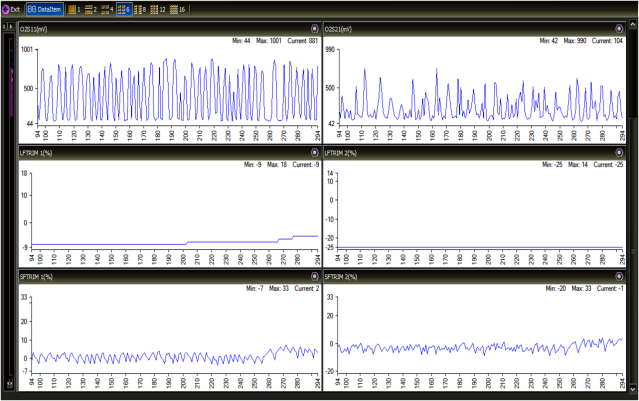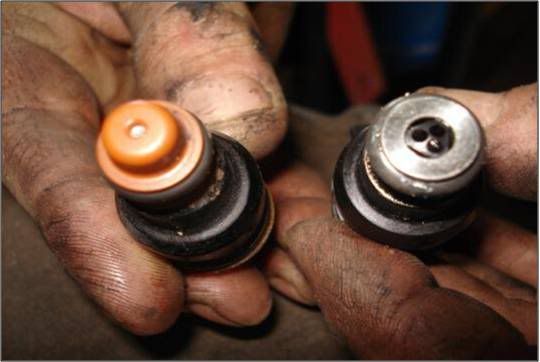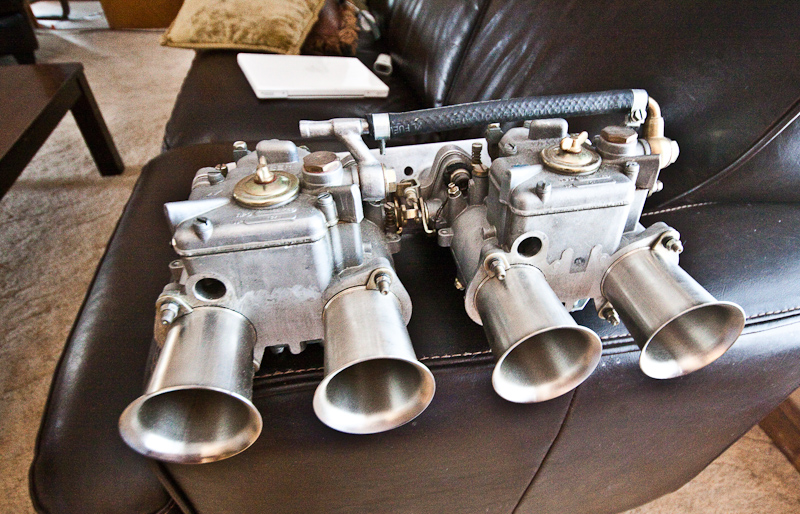joebiodiesel
I wish I could think of something witty to put her
At the risk of posting some info for a second time, I decided to start a separate thread on the hesitation/misfire my bike does at low RPMs. Some of this info is also in the CO Adjustment thread I posted a while back. If any of the Admins think it is inappropriate, take whatever action deemed necessary. No problem.
Like a lot of guys here I have spent a fair amount of time screwing around with my bike right after getting it. I played with the CO adjustments on the bike trying to smooth the idle. Bought a PCIII and hooked up my 5 gas. I learned an awful lot since I’ve started messing with it, and have the fuel mapping very close to how I want it. I no longer have a surge at low cruise speeds and still get 40-44 MPG pretty reliably when running slab. The only thing still killing me is the miss/hesitation at around 1700 RPMs. I’ve read posts here with cures ranging from PCIIIs to throttle cams. If you followed my thread on CO adjustments you already know I have been trying to figure out what the problem is.
Here is what I know:
The reason my bike misfires at 1700 RPMs, whether accelerating or cruising, is that it is seriously over-fueling due to unwanted acceleration enrichment. The computer appears to be overreacting to a noisy TPS signal, because removing the TPS signal fixes the problem 100%. Adjusting the TPS to higher and lower voltages moves the miss to different RPMs, but doesn’t make it go away.
One of the reasons we have a TPS on our bikes is to act as an accelerator pump. As the throttle opens, and engine vacuum drops, the engine needs lots of enrichment so it won’t hesitate. Without it, the engine would fall on its face, momentarily, when the throttle was opened rapidly. My bike adds this fuel, unnecessarily, at 1700 RPMs. You can easily see it because it uses extra injection pulses that are not timed to the firing sequence of the engine. They are called Asynchronous Pulses, and are pretty commonly used in fuel injected cars for this exact purpose.
If I disconnect the TPS on my bike, and add the necessary enrichment with the PCIII Accelerator Pump tool, the bike runs perfectly under all conditions except full throttle. The bike won’t top out, and pulls poorly at high RPMs.
Yesterday I got a chance to chance another ’08 FJR. Although I didn’t ride the bike, it does run poorly between 1500-2000 RPMs, just like mine. The guy let me put my lab scope on it. The injection pulses are just like my bike. I’m satisfied that this problem is not unique to my bike now.
Here is what a normal injection pattern looks like. This is only 2 of the 4 cylinders.
Don’t try to overanalyze these scope patterns. The resolution is too low for that. Each little notch is an injector firing. Ignore whether they have the spike at the end or not.
Normal Pattern
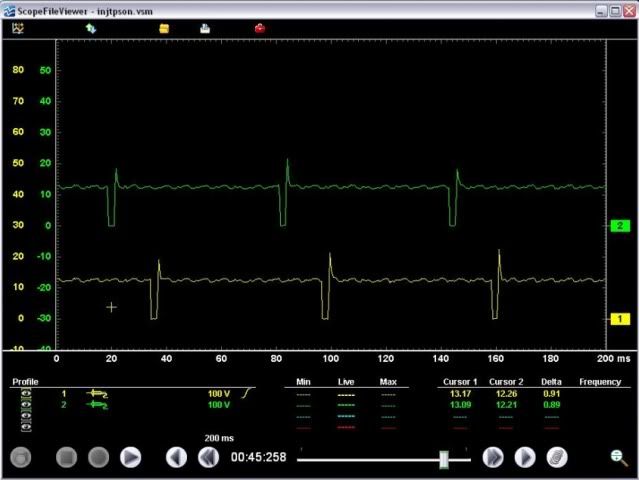
Here are a couple of screen shots of the 1500-2000RPM range. Note the untimed pulses.
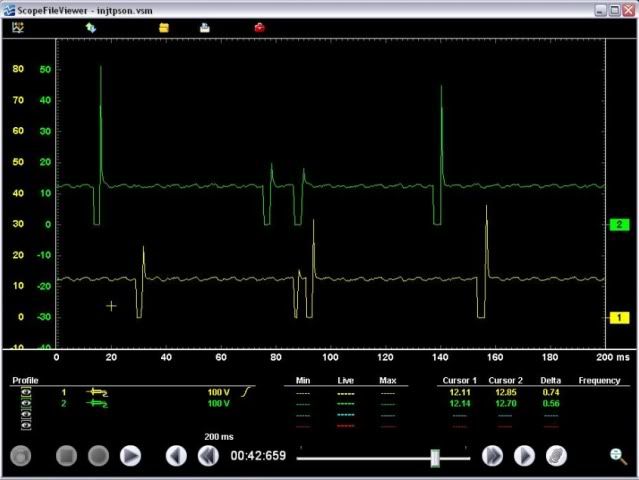
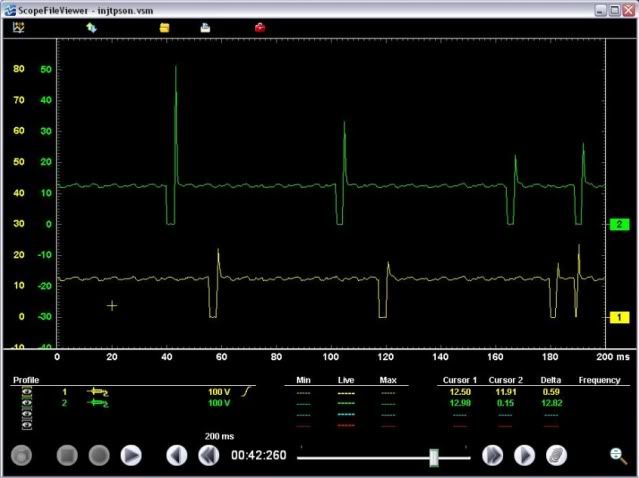
Compare these to the ones I got on my bike about a month ago.
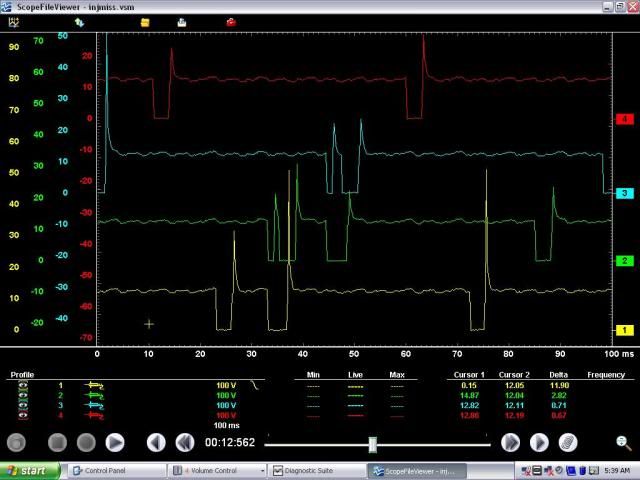
I don’t believe that this is a problem that only affects ’08 bikes. I’ve read too many posts from other people complaining of the same symptoms. I will check other FJRs as I come across them. Maybe I’ll be able to hit a Tech Day and check a bunch of them at the same time.
While I’m glad I’ve positively identified exactly what’s causing it, the cure is not going to be too easy. I don’t believe there is any way around it. I’ve tried cleaning up the TPS signal with negative results. I don’t believe it can be fixed without reprogramming the computer. If I get a chance to scope a couple of different year FJRs and can repeat my results, I may try tracking down the local Yamaha Service Rep to see what he has to say.
For now I am living with it, and clutching through 2000 RPMs like a rookie rider.
Questions/comments/insults are welcome.
Joe
Like a lot of guys here I have spent a fair amount of time screwing around with my bike right after getting it. I played with the CO adjustments on the bike trying to smooth the idle. Bought a PCIII and hooked up my 5 gas. I learned an awful lot since I’ve started messing with it, and have the fuel mapping very close to how I want it. I no longer have a surge at low cruise speeds and still get 40-44 MPG pretty reliably when running slab. The only thing still killing me is the miss/hesitation at around 1700 RPMs. I’ve read posts here with cures ranging from PCIIIs to throttle cams. If you followed my thread on CO adjustments you already know I have been trying to figure out what the problem is.
Here is what I know:
The reason my bike misfires at 1700 RPMs, whether accelerating or cruising, is that it is seriously over-fueling due to unwanted acceleration enrichment. The computer appears to be overreacting to a noisy TPS signal, because removing the TPS signal fixes the problem 100%. Adjusting the TPS to higher and lower voltages moves the miss to different RPMs, but doesn’t make it go away.
One of the reasons we have a TPS on our bikes is to act as an accelerator pump. As the throttle opens, and engine vacuum drops, the engine needs lots of enrichment so it won’t hesitate. Without it, the engine would fall on its face, momentarily, when the throttle was opened rapidly. My bike adds this fuel, unnecessarily, at 1700 RPMs. You can easily see it because it uses extra injection pulses that are not timed to the firing sequence of the engine. They are called Asynchronous Pulses, and are pretty commonly used in fuel injected cars for this exact purpose.
If I disconnect the TPS on my bike, and add the necessary enrichment with the PCIII Accelerator Pump tool, the bike runs perfectly under all conditions except full throttle. The bike won’t top out, and pulls poorly at high RPMs.
Yesterday I got a chance to chance another ’08 FJR. Although I didn’t ride the bike, it does run poorly between 1500-2000 RPMs, just like mine. The guy let me put my lab scope on it. The injection pulses are just like my bike. I’m satisfied that this problem is not unique to my bike now.
Here is what a normal injection pattern looks like. This is only 2 of the 4 cylinders.
Don’t try to overanalyze these scope patterns. The resolution is too low for that. Each little notch is an injector firing. Ignore whether they have the spike at the end or not.
Normal Pattern

Here are a couple of screen shots of the 1500-2000RPM range. Note the untimed pulses.


Compare these to the ones I got on my bike about a month ago.

I don’t believe that this is a problem that only affects ’08 bikes. I’ve read too many posts from other people complaining of the same symptoms. I will check other FJRs as I come across them. Maybe I’ll be able to hit a Tech Day and check a bunch of them at the same time.
While I’m glad I’ve positively identified exactly what’s causing it, the cure is not going to be too easy. I don’t believe there is any way around it. I’ve tried cleaning up the TPS signal with negative results. I don’t believe it can be fixed without reprogramming the computer. If I get a chance to scope a couple of different year FJRs and can repeat my results, I may try tracking down the local Yamaha Service Rep to see what he has to say.
For now I am living with it, and clutching through 2000 RPMs like a rookie rider.
Questions/comments/insults are welcome.
Joe




